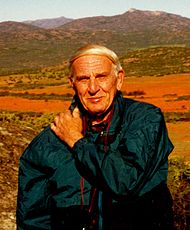Edward M. Burgess
| Edward M. Burgess | |
|---|---|

September 2001; Namaqualand, South Africa
|
|
| Born | 1934 Birmingham, Alabama, USA |
| Nationality | American |
| Fields | Chemist |
| Institutions |
Yale University Georgia Institute of Technology |
| Alma mater |
Auburn University Massachusetts Institute of Technology |
| Doctoral advisor | George Büchi |
| Doctoral students | Anthony Joseph Arduengo III |
| Known for | Burgess Reagent |
Edward Meredith Burgess (born 1934) is an American chemist. He specialized in organic chemistry with an emphasis on methodology, structure, and . He is best known for the Burgess reagent (methyl N-(triethylammoniumsulfonyl)carbamate) that is used for selective dehydration of alcohols.
Professor Burgess served as Secretary-Treasurer of the Organic Division of the American Chemical Society from 1974 to 1977.
Edward Meredith Burgess was born in Birmingham, Alabama in 1934. He attended Shades Valley High School in that city and was awarded the school's science award upon graduation in 1951. During the summers of his junior and senior high school years he obtained a job performing routine chores at the University of Alabama at Birmingham (UAB) Department of Biochemistry. It was during this period at UAB that Burgess began his career in chemical research. Under the guidance of the noted carbohydrate chemist, William Ward Pigman, he was given his own research project, the “Anhydrous Reaction of Nitrogen Dioxide with some Selected Sugars.”
In 1952 Burgess was awarded an NROTC scholarship and entered Auburn University with a dual major in chemistry and physics. During his undergraduate years at Auburn he undertook research in the laboratories of Frank Stevens (Chemistry) on the Synthesis of Indole Derivatives useful as Plant Growth Regulators and Howard Carr (Physics) on the construction of a mass spectrometer. He obtained his B.Sc. Degree (cum laude) in 1956.
...
Wikipedia
